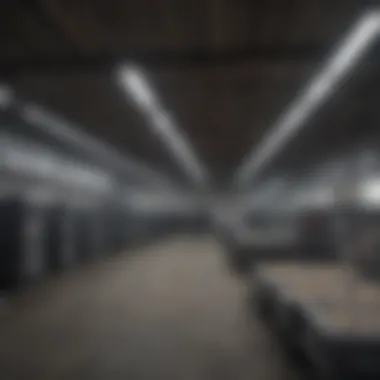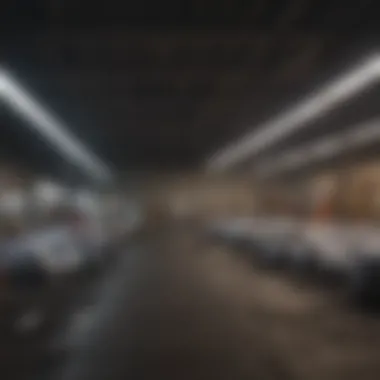Responsible Disposal of Old Fluorescent Tubes: A Guide


Overview of the Topic
The disposal of old fluorescent tubes presents significant challenges and responsibilities for individuals and organizations alike. As a common lighting choice, these tubes contain hazardous materials, including mercury, which can pose serious risks to both human health and the environment. The urgency of proper disposal practices will resonate in this discussion, as efficient management is no longer optional, but a crucial environmental duty.
The importance of knowing what to do with spent fluorescent tubes is paramount. Improper disposal can lead to leakage of harmful substances, creating pollution and threatening local ecosystems. Familiarity with both the impact of these tubes and their safe disposal channels plays an essential role in fostering a conscientious community aware of its ecological footprint.
Current Status and Challenges
Currently, in many places, there remains a lack of understanding or awareness regarding the hazards of fluorescent tube disposal. Numerous households still treat them simply as waste, putting single-use items in normal trash cans. This practice is not only illegal in numerous jurisdictions but also deeply harmful to nature. The excess mercury and phosphor in these tubes can increase in both soil and water systems ultimately affecting narrow links within the food chain. ACCESS to proper disposal options also varies widely.
Not every locale has user-friendly drop-off points or accessible recycling programs that actively promote the sustainable processing of fluorescent materials. The resultant fragmented implementation of disposal programs can create confusion about proper methods making it clear that informed community practices are pivotal in navigating these ecological challenges.
Sustainable Solutions
Transitioning to sustainable practices in disposing of fluorescent tubes entails both education and involvement. Simple awareness campaigns and local workshops can disseminate vital information regarding safe storage and disposal methods. Community organizations often promote local recycling initiatives, highlighting individually owned spaces like hardware stores or big-box retailers, where residents can return spent tubes.
Success is evident statistically. Towns that held periodic collection events observed substantial decreases in improper disposals, showcasing the beneficial effects of engagement in responsible practices.
Important resources for safe disposal include:
- Local municipal waste management department websites
- Major retailers such as Home Depot and Lowe’s commonly designed to accept fluorescent lights for recycling
- Specific environmental groups promoting waste diversion through innovative campaign wiring to passion for planet
Impact and Importance
The impact of improper disposal extends beyond direct pollution concerns, intricately linking to ecological and human health. Pollutants can mitigate air quality and safety for nearby wildlife, potentially leading to toxic buildup.
It is imperative to foster a culture that values responsible management because each action contributes to shaping the environment for future generations. Collective conscious decisions motivate superior legislation and improved opportunities for inventive resources allowing them access to clean habits. Only by truly understanding the ecological connectedness can society hope to harmonize its progress with nature.
Prolusion to Fluorescent Tube Disposal
Proper disposal of fluorescent tubes is critical both for environmental protection and regulatory compliance. These tubes contain materials that can be hazardous if not handled appropriately. This section will offer insights into the disposal of fluorescent tubes, detailing crucial benefits and considerations.
Understanding Fluorescent Tubes
Fluorescent tubes are widely used for their energy efficiency and bright, diffused light. They operate by passing an electric current through a gas, creating ultraviolet light, which then excites a fluorescent coating on the inside of the tube. One common type is the T8 fluorescent bulb. While they are efficient, certain components in these tubes, such as mercury, pose environmental risks.
Understanding what constitutes a fluorescent tube can influence disposal actions. Spare tubes may seem like trivial burdens, but collectively, they contribute to waste issues if not properly discarded. Most people do not realize that these innocent-looking pieces of lighting technology can leech contaminants into soil and water systems.
Key Overview of Fluorescent Tubes:
- Types include T5 and T8 bulbs.
- Used in residential, commercial, and industrial settings.
- Energy-efficient, but contain delicate glass and hazardous materials.
Why Safe Disposal Matters
The practice of safely disposing of fluorescent tubes is paramount for several reasons. First, toxic components within the tubes, particularly mercury, can severely harm both the environment and human health if released. Mercury is known to contaminate ecosystems and create long-lasting impacts on wildlife and vegetation.
In regions with laws regulating hazardous waste, improper disposal can invite penalties or fines. Failure to adhere to these regulations not only threatens the community’s health but can result in legal consequences for individuals and businesses alike. Therefore, actions taken today in handling fluorescent tubes will reflect on future generations.
Moreover, educating others about safe disposal enhances community responsibility. When individuals understand the impact of their actions, better choices can be made. The focus here recognizes disposing of fluorescent tubes as a small yet significant act of environmental stewardship. By acting responsibly, individuals contribute to a more sustainable future.
“Safe disposal of fluorescent tubes is not just a legal requirement; it is a cornerstone of responsible environmental practice.”
Thus, awareness of proper disposal options should resonate among communities and organizations.
Highlight: Responsible disposal of fluorescent tubes not only safeguards ecosystems but also ensures the well-being of communities relying on the environment’s resources.


Laws and Regulations Regarding Fluorescent Tube Disposal
The topic of laws and regulations surrounding fluorescent tube disposal is critical to understanding how society manages hazardous waste. Adherence to these guidelines helps not only in preserving the environment but also in maintaining public health. Fluorescent tubes contain toxic materials, particularly mercury, which can lead to serious environmental degradation if not disposed of correctly. Having a robust regulatory framework facilitates proper management of these substances, and understanding these laws is essential for anyone handling fluorescent lighting products.
Federal Regulations Overview
In the United States, the management of hazardous waste like fluorescent tubes falls under the Resource Conservation and Recovery Act (RCRA). The Environmental Protection Agency (EPA) classifies discarded fluorescent tubes as hazardous waste due to their mercury content. This law mandates that businesses and individuals must handle these materials in a particular way, ensuring they are collected, treated, recycled, or disposed of safely.
Here are some key points under federal regulations:
- Universal Waste Rule: Fluorescent tubes can be recycled under this rule, which streamlines the disposal process for hazardous materials. This encourages more efficient handling and reduces the regulatory burden on individuals and businesses.
- Proper Labeling and Storage: It is mandatory for businesses to store and display fluorescent tubes safely. Containers must be closed, labeled correctly, and adhered to protocols to prevent breakage and leakage.
- Recycling Mandate: Federal law supports and even mandates recycling of fluorescent tubes wherever feasible, reducing the direct land-filling of hazardous materials.
Understanding these federal guidelines helps in making informed decisions about disposal customized per individual storage and disposal capacities.
State and Local Regulations
Apart from federal legislation, each state may have specific laws that complement federal regulations. These regulations vary widely across states, often addressing details like:
- Local Recycling Options: Some states encourage municipalities or counties to set up facility drop-off locations for hazardous waste like fluorescent tubes. Residents are urged to familiarize themselves with their local options.
- Extended Producer Responsibility (EPR): In certain states, manufacturers of fluorescent tubes may face legislation that requires them to accept used products for recycling. This holds businesses accountable for their products throughout their lifecycle.
- Specific Disposal Fees: Some jurisdictions may impose fees for hazardous waste disposal, influencing user's disposal options.
Adhering to state and local laws ensures a more cohesive approach to managing fluorescent waste while aligning with regulations highlighted at the federal level. Each person must check their subset of regulations, possibly visiting state offices, websites, or utilizing municipal resources to be compliant.
Understanding multi-tiered disposal laws cultivates a culture of responsibility.
By following these regulations not only do we reduce our environmental impact, but we also engage actively in a system meant to protect our ecosystem. Disposing of fluorescent tubes according to these guidelines ultimately contributes to sustainability and public health safety.
Where to Dispose of Old Fluorescent Tubes
Disposing of old fluorescent tubes is not merely a logistical concern; it is an environmental responsibility. Improper disposal leads to significant hazards, including toxic substances that can contaminate soil and water. Hence, knowing where to take these tubes is crucial for individuals and organizations alike. This section aims to identify proper disposal options, emphasizing the importance and benefits of responsible practices.
Retailer Take-Back Programs
Many retailers have implemented take-back programs for fluorescent tubes. Stores like Home Depot and Lowe's often offer this service. It provides a convenient option for consumers to return unused or spent bulbs after purchase. This approach ensures that those tubes are managed correctly. When participating in these programs, customers contribute less to waste in landfills and mitigate environmental risks.
Educating consumers about the specifics of these programs is important. Different locations may have various terms or conditions for their take-back initiatives. Therefore, checking the retailer's policies is advisable before making a trip. Additionally, retailers may have careful handling procedures to implement, ensuring safety and compliance with applicable laws.
Local Recycling Facilities
Local recycling facilities play a significant role in the responsible disposal ecosystem. Often, these facilities accept fluorescent tubes and other hazardous materials. Individuals and businesses looking to recycle should search for a nearby facility equipped to handle such items. Municipal websites or community centers can often provide lists of accessible recycling centers.
The advantages of such recycling facilities are manifold. They have the protocols in place to recycle materials safely, thus reducing health risks associated with toxicity. Also, recycling promotes resource recovery, diverting waste from landfills. Consider contacting a local facility to understand their specific guidelines. This straightforward action can have a substantial cumulative impact on environmental conservation efforts.
Civic Collection Events
Civic collection events serve as another essential option for disposing of old fluorescent tubes responsibly. These events, organized by municipalities or community groups, create opportunities for residents to clean out hazardous waste. Individuals should keep an eye out for such events through community calendars or local government announcements. These events often take place at different times, making participation feasible.
Moreover, community collection efforts foster collective responsibility and awareness. Engaging in these events contributes to a larger cultural shift towards environmental stewardship. It emphasizes not just the importance of individual action but also community involvement in waste management. It is vital for participants to follow the arrangements and directions issued for these events to help maintain a smooth and safe operation.
Taking action with respect to fluorescent tube disposal is necessary for ecological health. By employing retailer take-back programs, utilizing recycling facilities, and participating in civic collection events, individuals can make effective contributions to conservation.
By understanding these diverse disposal options, individuals can make informed decisions that align with both their convenience and environmental responsibility.
Preparing Fluorescent Tubes for Disposal
The process of preparing fluorescent tubes for disposal is crucial. Handling and packaging these tubes correctly minimizes risks and ensures compliance with regulations. Fluorescent tubes contain hazardous materials like mercury, requiring careful treatment before disposal. The significance of these preparations cannot be overstated, as improper handling can lead to breakage, environmental contamination, and legal ramifications.


Handling Precautions
Before you dispose of fluorescent tubes, it is essential to follow certain handling precautions. Here are some important points:
- Personal Protection: Always wear gloves and safety goggles when handling fluorescent tubes. This protects against potential breakage and the harmful contents inside.
- Avoid Dropping: Fluorescent tubes are fragile. Ensure a safe environment while carrying them.
- Proper Tools: Use appropriate tools to manage fluorescent tubes, including a sturdy box or container that can safely hold them.
- Immediate Clean-Up: In case of breakage, avoid direct contact with the shards. Use a damp paper towel or other means to clean up safely. Dispose of the clean-up materials in accordance with local regulations.
Remember: It’s not only about disposal; it’s about doing it rightly to protect yourself and the environment.
Packaging Fluorescent Tubes
The packaging of fluorescent tubes for disposal requires careful thought to ensure safe transport and recycling. Here are some detailed considerations:
- Use Original Packaging: If possible, use the tubes’ original packaging as it is designed to safeguard the fragile tubes during transport.
- Sturdy Container: If original boxes are unavailable, select a strong and robust container that can securely hold the tubes during transport. Ensure that it is clearly labeled to indicate it contains hazardous waste.
- Wrap Individually: If transporting multiple tubes, wrap each one in bubble wrap or newspaper. This added layer helps prevent breakage in transit.
- Seal Container: When placing tablets or tubes in a container, seal it securely to prevent it from opening unintentionally. Use sturdy packing tape for added safety.
- Transport Carefully: Keep the container upright while transporting to minimize the risk of breakage and exposure to hazardous contents.
Prioritizing the safe handling and significant packaging of fluorescent tubes paves the way for a responsible disposal process, aligning with both community standards and environmental protection efforts.
Benefits of Recycling Fluorescent Tubes
Fluorescent tubes are common in many residential and commercial buildings. They are known for their energy efficiency but pose specific challenges at the end of their life. Recycling these tubes offers multiple significant advantages that extend beyond just waste management. Understanding these benefits helps establish a clearer path to responsible disposal practices.
Resource Recovery
When fluorescent tubes reach the end of their useful life, they contain a variety of material that can be recovered. These include glass, metals like aluminum and phosphor, and other components. By recycling fluorescent tubes, we engage in resource recovery. This process relies heavily on breaking down the tubes into their base materials for reuse.
The first benefit here is the conservations of primary natural resources. The recycling of glass and metals reduces the need for virgin materials, making resource extraction less necessary. Secondly, recycling contributes directly to lowering energy consumption. Processing recycled materials typically requires less energy than acquiring and refining raw materials.
However, this is not a one-way street. The efficiency of the recycling system is dependent on popular community support. Programs and initiatives must be in place that allow individuals to participate in recycling. Participation reduces material ending up in landfills, which can lead to serious environmental concerns.
“Resource recovery from waste is a cornerstone for a sustainable future.”
Reducing Environmental Footprint
The environmental footprint of improperly disposed fluorescent tubes can be significant. These tubes often contain mercury, which poses serious environmental threats if tubes break in the waste stream. Recycling mitigates this risk by processing them in controlled environments. It ensures that hazardous substances are handled safely and do not contaminate soil or water supply, which can lead to long-lasting ecological damage.
Reducing an environmental footprint also relates to the carbon emissions associated with production. By recycling materials, we help decrease the emissions generated during the manufacturing of new products. In summary, recycling fluorescent tubes allows consumers and businesses to participate actively in sustaining our environment.
To implement a robust recycling culture, communities ought to prioritize both education and accessibility to recycling centers. Contact local agencies to awareness of drop-off points specifically for fluorescent tube recycling. This step brings all community members into the fold of a more sustainable future.
Community Initiatives for Fluorescent Tube Disposal
Community initiatives play a crucial role in promoting responsible disposal of old fluorescent tubes. They help raise awareness about the hazards associated with improper disposal while fostering collective efforts toward sustainable practices. As communities face environmental challenges, these initiatives create platforms for education, engagement, and action.
Effective community programs can mobilize individuals, companies, and organizations to ensure fluorescent tubes are disposed of in a safe manner. These programs often include a variety of strategies, from educational campaigns to collaboration with local waste management services. They create a sense of joint responsibility that resonates through neighborhoods, leading to meaningful change.
Educational Awareness Programs
Educational awareness programs serve as the backbone of community efforts to manage fluorescent tube disposal. Offering comprehensive information about the dangers that hazardous waste present, these programs encourage informed decision-making among residents.
Such initiatives may cover topics including:
- Environmental risks linked to toxic materials found in fluorescent tubes, such as mercury.
- Safe handling practices for fluorescent tubes, promoting safe storage and transportation before disposal.
- Resource availability, guiding individuals toward local recycling facilities or community collection events.
Communities often conduct workshops, seminars, or informational sessions in schools and community centers, engaging participants at all ages. By providing clear and actionable information, these programs foster an environment where responsible disposal can thrive. People become more mindful of their waste and are thus better equipped for proper action.
Partnerships with Local Organizations


Collaboration with local organizations is equally vital for enhancing the impact of community initiatives focused on fluorescent tube disposal. By linking with environmental groups, waste management companies, or public health organizations, communities can share resources, knowledge, and broader visibility.
Key partnerships may help with:
- Organizing collection events that allow residents to conveniently dispose of fluorescent tubes at designated times and locations.
- Employing specialized recycling firms to handle hazardous waste safely and legally.
- Creating shared marketing materials that inform citizens about the importance of responsible disposal practices.
Establishing enduring partnerships can lead to long-lasting solutions, ensuring that proper disposal facilities remain accessible. It also engenders trust among community members regarding the capacities and credentials of their partners. This sense of accountability encourages wider participation from the public and powerful collective action as emphasized objectives are met by paired teamwork from different sectors.
A coordinated community effort can significantly increase responsible disposal rates and contribute to healthier environments and sustainable ecosystems.
Potential Alternatives to Fluorescent Tubes
Finding alternatives to fluorescent tubes can play a significant role in creating more sustainable lighting solutions. In light of environmental issues, people are increasingly recognizing the need to reduce their usage of traditional lighting. This includes understanding the benefits and considerations linked to energy-consuming technologies. By exploring viable advancements, individuals and organizations can further minimize their environmental footprint.
Energy-Efficient Lighting Options
Switching to energy-efficient lighting options is essential in minimizing energy consumption. A key benefit of energy-efficient alternatives is that they consume less power while delivering the same, often improved, light quality. Many of these lighting options lead to reduced electricity bills over time.
Several noteworthy energy-efficient lighting options are:
- Compact Fluorescent Lamps (CFLs):
- Light Emitting Diodes (LEDs):
- CFLs consume around 70% less electricity than traditional incandescent bulbs. While they are better than older models, CFLs still contain mercury.
- LEDs are exceptionally energy-efficient and have a long life span. They consume up to 80% less electricity than incandescent bulbs and can last between 15,000 to 50,000 hours before needing replacement.
In consideration of lighting choices, factors such as dimmability, color temperature, and application areas should be examined. Lastly, the initial cost of switching might be higher, but the benefits in the long run often outweigh the expenses.
Transitioning to LED Lighting
The transition to LED lighting stands out as one of the most impactful changes individuals and organizations can make. This transition does not just involve replacing bulbs; it often requires adapting to completely new systems designed to facilitate LED integration effectively.
Some factors regarding transitioning to LED lighting include:
- Long-Term Savings:
- Environmental Benefits:
- Safety Considerations:
- Although initial prices may deter some people, the lifespan and efficiency of LEDs offer significant long-term financial benefits.
- LEDs produce far less heat, removing the need for additional cooling energy. This results in reduced overall energy demand and lowers greenhouse gas emissions.
- LEDs are cooler than traditional bulbs, which reduces the chances of burns or fires.
Making the switch requires planning and perhaps minor adjustments to existing fixtures. In urban or rural areas, individuals can investigate local suppliers or online purchases to ensure a smooth transition.
Culmination
Proper disposal of old fluorescent tubes is of great importance not only for individuals but also for the community and environment. This article covers essential aspects of responsible disposal, emphasizing the need to understand local laws and available options.
Summarizing Key Points
Fluorescent tubes contain toxic components that can harm the environment. Understanding their specific disposal requirements protects both soil and water. It is crucial to recognize retailers that offer take-back programs and to identify local recycling facilities. Awareness of civic collection events can further enhance proper disposal practices.
Understanding laws related to fluorescent tube disposal helps in avoiding legal penalties and contributes to environmental responsibility. By recycling fluorescent tubes, we can recover valuable components, reduce waste, and minimize our environmental footprint.
Call to Action for Responsible Disposal
Individuals must take personal responsibility for the disposal of fluorescent tubes. Not only is it a legal matter but more so an ethical obligation toward the environment.
- Check with local retailers and recycling facilities for disposal options.
- Participate in community efforts and initiatives that promote proper disposal.
- Embrace new lighting alternatives such as LED,
Prioritizing safe disposal means acknowledging the potential consequences of carelessness. Together, we can foster a culture of responsibility and environmental stewardship for future generations.



